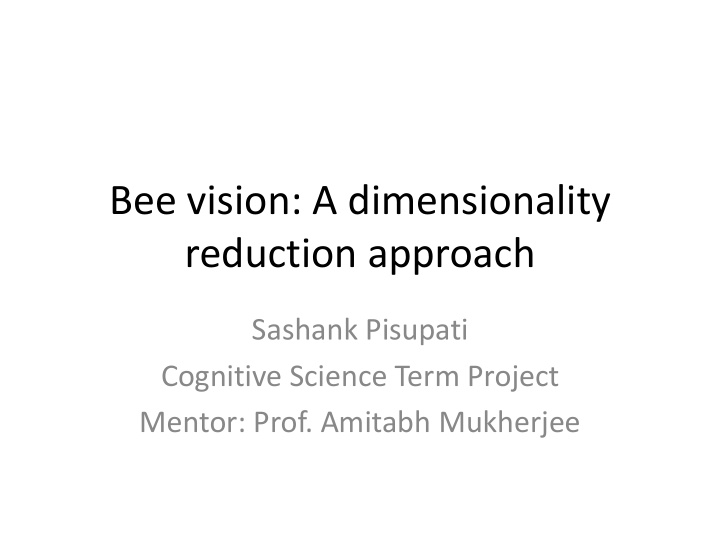



Bee vision: A dimensionality reduction approach Sashank Pisupati Cognitive Science Term Project Mentor: Prof. Amitabh Mukherjee
Motivation • Bees rely heavily on visual cues to locate themselves, and combine these with scent cues to learn about good sources of nectar • The (single) neurons that do this learning must receive visual input that – Is low dimensional (Steveninck, Bialek & Ruyter) – Reliably represents feedback to the motor acts
*Dimensionality reduction: what? • The stream of visual input is very high dimensional • Useful information however (for example which direction I am moving in) is much lower dimensional • Most feature sensitive neurons are only sensitive to low dimensional subspaces of inputs.
*Dimensionality reduction: how? • Nonlinear dimensionality reduction of images using methods such as Dijkstra algorithm (Isomap) • Can discover low dimensionality of the inputs Claim: This can be achieved linearly through hebbian learning, or nonlinearly through lateral inhibitory structures such as in the insect brain (Reichardt )
Dimensionality reduction: why? Claim: Images of/seen by a system with ‘n’ degrees of freedom will lie on an ‘n’ dimensional manifold (Amitabh, Ram et. Al) • This low dimension is useful because it matches DoF, for visuomotor feedback • Entire set of images must be preserved – Memory intensive – But because of this, bee can adapt – Different situations will have entirely different image sets but low dimensional computation can remain same.
Can the bee moving around, by virtue of visual stimulus alone, figure out where it is? low dimensional understanding matching its degrees of freedom
Virtual bee: The setup Setup: Andy Giger’s B EYE, that simulates a single array of the bee’s photoreceptors, taking into account the optical properties and limitations of the bee’s ommatidae: http://andygiger.com/science/beye/beyehome.html
Virtual bee: The experiment
Virtual bee: The experiment • Images collected for both 2d motion (two degrees of freedom, X,/Y) as well as 3d (three degees of freedom X/Y/Z)
Virtual bee: The results
Conclusions so far • The dimensions of the low-dimensional visual input is representative of the degrees of freedom of the bee • The bee can hence use this low dimensional description to infer where it is (i.e. its coordinates or configuration) • This low dimensional data can now be used by higher order “feature sensitive” neurons, and is adaptive to context.
The next step: closed loop bees • Since this low dimensional input is of the same dimension as motor DoF, it can be used as input to a reinforcement learning neuron • Such a neuron would then learn which parts of the environment are full of nectar and hence drive the bee towards those parts.
The next step: closed loop bees • Similar to Montague & Sejnowski’s model, one could now input the coordinates of the bee into the neuron P to learn nectar source location
References Bee vision • Lehrer, Myriam, et al. "Motion cues provide the bee's visual world with a third dimension." (1988): 356-357. • Srinivasan, M. V., S. W. Zhang, and K. Witney. "Visual discrimination of pattern orientation by honeybees: Performance and implications forcortical'processing." Philosophical Transactions of the Royal Society of London. Series B: Biological Sciences 343.1304 (1994): 199-210. • Paulk, Angelique C., et al. "Visual processing in the central bee brain." The Journal of Neuroscience 29.32 (2009): 9987-9999. Dimensionality reduction : neural principles of feature extraction and motion estimation in insect vision • Bialek, William, and Rob R. van Steveninck. "Features and dimensions: Motion estimation in fly vision." arXiv preprint q-bio/0505003 (2005). Single neuron computations using low dimensional inputs • Montague, P. Read, et al. "Bee foraging in uncertain environments using predictive hebbian learning." Nature 377.6551 (1995): 725-728. • Soltoggio, Andrea, et al. "Evolving neuromodulatory topologies for reinforcement learning-like problems." Evolutionary Computation, 2007. CEC 2007. IEEE Congress on. IEEE, 2007. • Niv, Yael, et al. "Evolution of reinforcement learning in foraging bees: A simple explanation for risk averse behavior." Neurocomputing 44 (2002): 951-956.
Recommend
More recommend